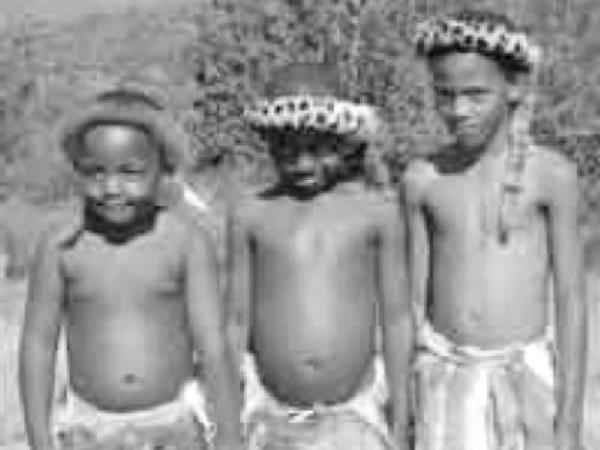
Figure 1.--Here are Zulu children in modern South Africa wearing traditionl clothes. Killing wild animals were an important accomplishment for Zulu boys. |

|
South Africa is an ethnically diverse country. The racial composition in 2000 was about: black (75 percent), white (14 percent), colored (9 percent), and Indian (3 percent). [CIA Factbook.] Other estimates exist. Some show the white populationa s low as 8 percent of the population. [South Africa On-Line Travel Guide.] The black population itself is very diverse. The Zulus (21 percent) are the largest group. Other groups include Xhosas (17 percent), Sothos (15 percent), and a large number of smaller tribes. The White population consists of Afrikaners (descended from Dutch, French, and other European immigrants) and English settlers. Indians were brought into South Africa to work on sugarcane plantations and they are still concentrated in Natal. Famed Indian leader Mahatma Gandi soent his formative years in Natal. There are smaller groups like the indigenous San and Khoikhoi and the Cape Malays who were brought as slaves from East India by the Dutch in the 18th century.
The mahority of the white South Africans are Afrikaners. They were formerly known as the Boers. The term "boer" is the Duch word for farmers. The Boers today are the descendents of the Durch who founded Cape Colony in southern Africa (1652). The Dutch settlers initially estblished a colony at Cape Town near the stratehic Cape of Good Hope to support shipping around Africa to Asia. French Huguenots (Protestants) fleeing religious supression arrived
(1687) and inter-married with the Dutch. The strict Calvinism of the Boers and their conflict with the vast native population as well as conflivts with the despotic Dutch East India company developed a spirit of rugged independence in the Boers. The Dutch ceeded the Cape Colony to Britain (1814) near the end of the Napoleonic Wars in Europe. Conflict with the British began almost at once, but intensified after the British freed the
slaves that the Boers still held (1834). The nationality question was finally settled by the Boer War (1899-1902)
The Cape Malays are Muslims. As a matter of fact they were the first to bring Islam to South Africa.
The Cape Malays are a thriving section of South African society. Their ancestry is very heterogeneous indeed: Malays, Indonesians, but also whites and people from Ceylon and India. It was the Malays who first recorded documents in Afrikaans. Around 1850, when the Dutch settlers officially held on the Standard Dutch, religious texts in Afrikaans for the use of Muslim Cape Malays were printed in Istanbul, Turkey. They are still today almost exclusively Islamic by faith. The community remains large and vibrant.
They speak Afrikaans among themselves and were classified as "coloureds" during the apartheid era.
Interestingly, the Cape Malays developed an impressiuve tradition of choral singing. As far as we know this is the only Muslim community to develop asn important choral tradition.
Indians were brought into South Africa to work on sugarcane plantations and they are still concentrated in Natal. Famed Indian leader Mahatma Gandi soent his formative years in Natal.
Khokhoi is the current politically correct designation for the Hottentot people. They are one of two peoples that the Dutch encountered when they first settled in the Cape Province, which means that they were the only indigenous peoples to have lived there before the whites landed and the Bantu peoples (Zulu, Sotha etc.) moved southward. The Khoikhoi as a separate people do not any longer exist: they have married into the white, coloured and black population to the extent that their language and customs have disappeared. Their descendents are mostly Christians.
The San were the other indegenious people encounteed by the Dutch in the 16th century. The San (also called Bushmen in English and Boesmans in Afrikaans) still practice their hunting lifestyle in large parts of South and South-West-Africa as well as in Botswana. They speak a variety of related languages. Most of them are either animists or Christians. They are a fascinating people, famous for their hunting skills and ability to survive in their arid, drought-stricken homeland through their intimate knowledge of its vegetation and wildlife.
The Sothos (15 percent of the South African population) are a major population group.
The Zulus (21 percent of the South African population) are the largest ethnic hroup in South Africa. They are the southern branch of the Bantu speaking people. The Mantabele are a group of the Zulu. The Zulu had polygamous marriages and was normally contracted by gifts of cattle to the father of the bride. The Zulu lived in fenced compounds called kraals. The warlike Zulu moved into southern Africa during the early 19th century and with their superior tactics and organization subdued local tribes. They came in conflict with the Afrkaaners fleeing British rule on the Long Trek (1830s). Andries Pretorius led reprisals raids against the Zulu, killing large numbers. The Zulus were finally subdued by the British in the Zulu War (1879). Zuiluland was anned by the British (1887) and was made part of Natal (1897).
The Xhosas (17 percent of the South African population) are a major population group.
Navigate the Boys' Historical Clothing South African pages:
[Return to the Main South African page]
[S.A. school uniforms]
[S.A. choirs]
[S.A. scouts]
Navigate the Boys' Historical Clothing Web Site:
[Introduction]
[Activities]
[Biographies]
[Chronology]
[Clothing styles]
[Countries]
[Bibliographies]
[Contributions]
[FAQs]
[Glossaries]
[Images]
[Links]
[Registration]
[Tools]
[Boys' Clothing Home]
